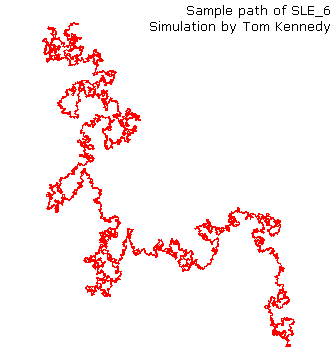
Stochastic Activity Month
February 22
2012
Lecture Afternoon
"Scaling limits"

| SPEAKERS | REGISTRATION |
Federico Camia (VU Amsterdam)
Anne Fey (TU DElft)
Jesse Goodman (University Leiden)
Wouter Kager (VU Amsterdam)
For organizational purposes, please register online: Registration form
| 13.20 - 14.10 | Jesse Goodman | Scaling limit of invasion percolation on regular trees |
| 14.10 - 15.00 | Anne Fey | Continuum bootstrap percolation |
| 15.00 - 15.30 | Coffee/tea break | |
| 15.30 - 16.20 | Federico Camia | The Massive Brownian Loop Soup |
| 16.20 - 17.10 | Wouter Kager | The combinatorial approach to the Ising model |
Federico Camia
The Massive Brownian Loop Soup
The Brownian Loop Soup is a Poissonian collection of Brownian loops in the plane. It is conjectured to describe the scaling limit geometry of various two-dimensional models of statistical mechanics at their critical points, such as the critical Ising model. Critical models are known to give rise to "massless" (scale-invariant) field theories in the scaling limit. Is there a variant of the Brownian Loop Soup that describes the geometry of ''near-critical'' scaling limits, corresponding to "massive" (non-scale-invariant) field theories? I will identify a possible candidate, explain why it is a natural choice, and show how it provides a first positive answer to the question above in the context of the Gaussian Free Field.
Anne Fey (TU Delft)
Continuum bootstrap percolation
Bootstrap percolation
models are usually defined on the sites of a lattice or graph, but rarely on a
continuum space. We consider a novel model on R^d. We start from a continuum
percolation configuration consisting of unit balls centered at the points of a
Poisson point process of intensity lambda. Then we iterate: loosely speaking, if
there is a cluster of overlapping balls at most a distance R(lambda) from the
origin, then we add a ball to the configuration, namely the smallest one that
covers the cluster. Will the whole of R^d eventually be in the interior of a
ball?
We find evidence for a sharp threshold behavior as lambda tends to 0, much like
earlier results for lattice bootstrap percolation models.
Jesse Goodman (University Leiden)
Scaling limit of invasion percolation on regular trees
Invasion percolation
is a percolation-like process for growing a cluster dynamically. It produces
an infinite cluster with many of the scaling properties of critical
clusters, and is therefore related to the incipient infinite cluster.
We describe the scaling limit of the invasion cluster when the underlying
graph is a regular tree. The limiting object, which is a random,
non-compact, continuous tree, is related to the continuum random tree of
Aldous. We describe this tree in terms of a stochastic process driven by
Brownian motion with a random and inhomogeneous drift.
Wouter Kager (VU Amsterdam)
The combinatorial approach to the Ising model
The two-dimensional Ising model is one of the most studied models in statistical mechanics. Surprisingly, however, the combinatorial approach to this model is relatively unknown in the probabilistic community, even though it stays much closer to probabilistic methods than the celebrated Onsager approach. We will discuss how the phase transition in the 2d Ising model can be studied via the combinatorial method, as an appealing alternative to the Onsager approach.